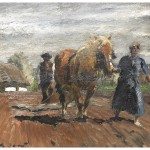
Zwei ineinander geflochtene Hände – Mkoenitzer – CC BY – SA 4.0
Where were we? Right, gaudium. Joy. Specifically, the joy that springs from charity and how that relates to friendship as Saint Thomas defines it. Nault tells us that through the history of philosophy (and, one assumes, less formal modes of approaching wisdom), friendship has always been considered a value, but Saint Thomas was the first to define charity as a type of friendship. This is Saint Thomas Aquinas we’re talking about here, so of course he takes time to build his case from the ground up, beginning by defining characteristics of friendship. Nault points to three:
-
First of all, there is a love of benevolence. In this regard, it is necessary to recall the classic distinction between two sorts of love; the love of concupiscence or of desire, which is self-directed (amor concupiscentiae), and the love of benevolence or of friendship, which is directed toward the other (amor benevolentiae).
-
Furthermore, reciprocity is necessary: this is the mutua amatio. I can love someone, but if that person does not love me in return, he is not truly my friend, and there is no real friendshipFinally, there has to be something in common between the two friends: this is the communicatio.
-
Finally, there has to be something in common between the two friends: this is the communicatio.
Having defined friendship but its attributes, Saint Thomas then asks if friendship is possible between God and man. The first requirement of benevolence is fulfilled on God’s part, certainly, and on man’s part occasionally (although man’s loyalties are split between both benevolentiae and concupiscentiae). The second requirement is definitely possible. And the third, although it might seem a bit complicated on its surface – the chasm between God and man appearing so vast – the fact that God invites us to participate in His life through beatitude bridges the gap.
Even if you don’t know much about Saint Thomas, I’m sure you’re familiar with his incorporation of Aristotelian thought. And it’s at this point in the discussion of friendship and acedia that Saint Thomas quotes Aristotle’s Nicomachean Ethics in saying “For what we do by means of our friends, is done, in a sense, by ourselves” (I – II, q. 5, a. 5, ad I., using the 1966 David Ross translation). It’s a fascinating idea to apply to the relationship between God and man, and in this context is an especially moving and deep expression of our connectedness to God.
But it also gestures at a trait of acedia. These definitions which connect friendship, charity, and joy, become the background to understanding an aspect of acedia that Saint Thomas was the first to formulate: Acedia is a sadness at participating in a friendship with God instead of a joy in the relationship, the result of one confusing good ends with bad. Nault more fully explains and contextualizes:
In the Summa Theologiae, Saint Thomas does not explain how man can come to be sad about what is nevertheless his ultimate good. But in his treatise De malo, he poses the question frankly: If it is quite logical that every agent should act first out of love, then how is it that man can be saddened in the presence of God? And Thomas answers: Man is capable of being sad in the presence of God because for God’s sake, he must renounce other goods that are carnal, temporal, limited, apparent goods, which on the scale, though, will weigh more than spiritual good, which may seem much less concrete than some particular good that is immediately attainable.
Shorter: You gotta serve somebody, and acedia is to choose poorly.
Next up: Saint Thomas’ second definition of acedia – disgust with activity











